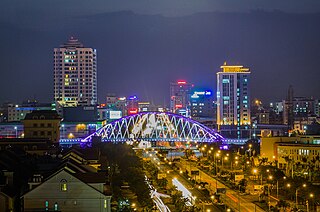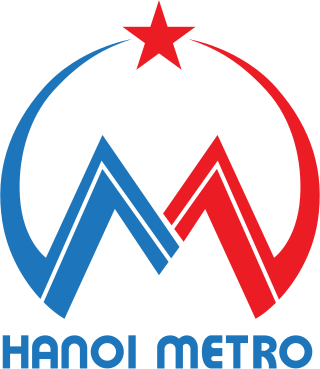
Hanoi is the capital and second-most populous city of Vietnam. It covers an area of 3,359.82 km2 (1,297.2 sq mi). It consists of 12 urban districts, one district-leveled town and 17 rural districts. It is located within the Red River Delta of Northern Vietnam.

Transportation in Vietnam is improving rapidly in terms of both quantity and quality. Road traffic is growing rapidly but the major roads are dangerous and slow to travel on due to outdated design and an inappropriate traffic mix. In recent years, the construction of expressways has accelerated. Air travel is also important for long distance travel. Metro systems are under construction in the two metropolises of Hanoi and Ho Chi Minh City.

Da Nang or Danang is a class-1 municipality and the fifth-largest city in Vietnam by municipal population. It lies on the coast of the East Sea of Vietnam at the mouth of the Hàn River, and is one of Vietnam's most important port cities. As one of the country's five direct-controlled municipalities, it falls under the administration of the central government.

Haiphong, or Hai Phong, is the third-largest city in Vietnam. An industrial city, Haiphong is located at the mouth of the Cấm River in northern Vietnam and population is about 2.389 million people as of 2022. Haiphong is the center of technology, economy, culture, medicine, education, science and trade in the Red River Delta. In the past, Haiphong was the first place with electricity in Vietnam.

Vietnam Railways is the state-owned operator of the railway system in Vietnam. The principal route is the 1,727 km (1,100 mi) single-track North–South Railway line, running between Hanoi and Ho Chi Minh City. This was built at the metre gauge in the 1880s during the French colonial rule. There are also standard gauge lines running from Hanoi to the People’s Republic of China, eventually leading to Beijing, and some mixed gauge in and around Hanoi.

The Yunnan–Haiphong railway is an 855 km (531 mi) railway built by France during 1904–1910, connecting Haiphong, Vietnam, with Kunming, Yunnan province, China. The section within China from Kunming to Hekou is known as the Kunming–Hekou railway, and is 466 km (290 mi) long. The section within Vietnam is 389 km (242 mi) long, and is known as the Hanoi–Lào Cai railway. The railway was built with 1,000 mm gauge due to the mountainous terrain along the route. Currently it is the only main line in China using 1,000 mmmetre gauge.
The North–South express railway is a proposed high speed railway in Vietnam. The line would begin in Lạng Sơn, crossing Bắc Giang, Bắc Ninh, Hanoi, Hà Tây, Hà Nam, Ninh Bình, Thanh Hóa, Nghệ An, Hà Tĩnh, Quảng Bình, Quảng Trị, Thừa Thiên-Huế, Đà Nẵng, Quảng Nam, Quảng Ngãi, Bình Định, Phú Yên, Khánh Hòa, Ninh Thuận, Bình Thuận, Đồng Nai, Bình Dương, Ho Chi Minh City, Long An, Tiền Giang, Vĩnh Long, Cần Thơ, Hậu Giang, Sóc Trăng, Bạc Liêu and ending in Cà Mau. The rail line would connect the two most urbanised areas in Vietnam, Hanoi in the North's Red River Delta in and Ho Chi Minh City in the South's Mekong River Delta. The total proposed length would be 2,070 kilometres (1,290 mi), compared with the 1,726-kilometre (1,072 mi) of the old railway line. The cost of the line is estimated at US$55.85 billion, to be funded by official development assistance from Japan and by the Vietnamese government itself. The project is planned to be implemented in three phases: Lang Son to Hanoi (170 km); Hanoi to Vinh city (285 km); Vinh City to Nha Trang (896 km); Nha Trang to Ho Chi Minh City (364 km); Ho Chi Minh City to Can Tho (139 km); Can Tho to Ca Mau (216 km). Construction activities on the first phase are expected to commence in 2020, and the whole project is scheduled for completion in 2050. This project is part of the country's railway transport development strategy by 2020 with a vision to 2050. The project is also part of the Trans-Asian railway network.

The railway system in Vietnam is owned and operated by the state-owned Vietnam Railways. The principal route, the single track North-South Railway running between Hanoi and Ho Chi Minh City, accounts for 1,726 kilometres (1,072 mi) of the network's total length of 2,600 kilometres (1,600 mi). The national railway network uses mainly metre gauge, although there are several standard gauge and mixed gauge lines in the north of the country.

The North–South railway is the principal railway line serving the country of Vietnam. It is a single-track metre gauge line connecting the capital Hanoi in the north to Ho Chi Minh City in the south, for a total length of 1,726 km (1,072 mi). Trains travelling this line are sometimes referred to as the Reunification Express, although no particular train carries this name officially. The line was established during French colonial rule, and was completed over a period of nearly forty years, from 1899 to 1936. As of 2005, 191 of Vietnam's 278 railway stations were located along the North–South line.

Railway crashes and derailments in Vietnam are common. In 2010, 451 railway incidents were reported across the country's railway network, having caused 211 deaths and 284 injuries. A joint Japanese-Vietnamese evaluation team reported in 2007 that the poor state of railway infrastructure was the fundamental cause for most railway incidents, of which the most common types were train crashes against vehicles and persons, especially at illegal level crossings; derailments caused by failure to decrease speed were also noted as a common cause of accidents. As of 2010, around 90% of all railway incidents occurred at level crossings without safety fences, and most were said to have been caused by motorists failing to follow traffic safety laws.

The Hanoi Metro is a rapid transit system in Hanoi, the capital city of Vietnam. Owned by Vietnam Railways and operated by Hanoi Metro Company (HMC), it is the first operational rapid transit system in Vietnam. The first line opened to service on 6 November 2021.

The D19E, also known as Đổi mới, is a series of diesel locomotives currently used on the Vietnamese railway network.

An egg coffee is a Vietnamese drink traditionally prepared with egg yolks, sugar, condensed milk and robusta coffee. The drink is made by beating egg yolks with sugar and condensed milk, then extracting the coffee into the cup, followed by a similar amount of egg cream, or egg yolks which are heated and beaten, or whisked.

Line 2A, Hanoi Metro, also known as Cát Linh line, is an elevated mass transit railway line, and part of the Hanoi Metro network. It is the first rapid transit line to operate in Vietnam, and was opened for service on 6 November 2021.

Hanoi–Đồng Đăng railway is a railway line in the country of Vietnam. It is a single-track standard-gauge and metre-gauge (dual-gauge) line connecting the capital Hanoi to Đồng Đăng, on the China-Vietnam border in Lạng Sơn Province. It has a total length of 162 km (101 mi).
Thường Tín station is a railway station in Thường Tín town, Thường Tín district, Hanoi. It's located near National Route 1 on the North–South railway.
Phú Xuyên station is a railway station on the North–South railway and is located in Phú Xuyên, Hanoi.

Hanoi Kitchen is a Vietnamese restaurant in Portland, Oregon.








































